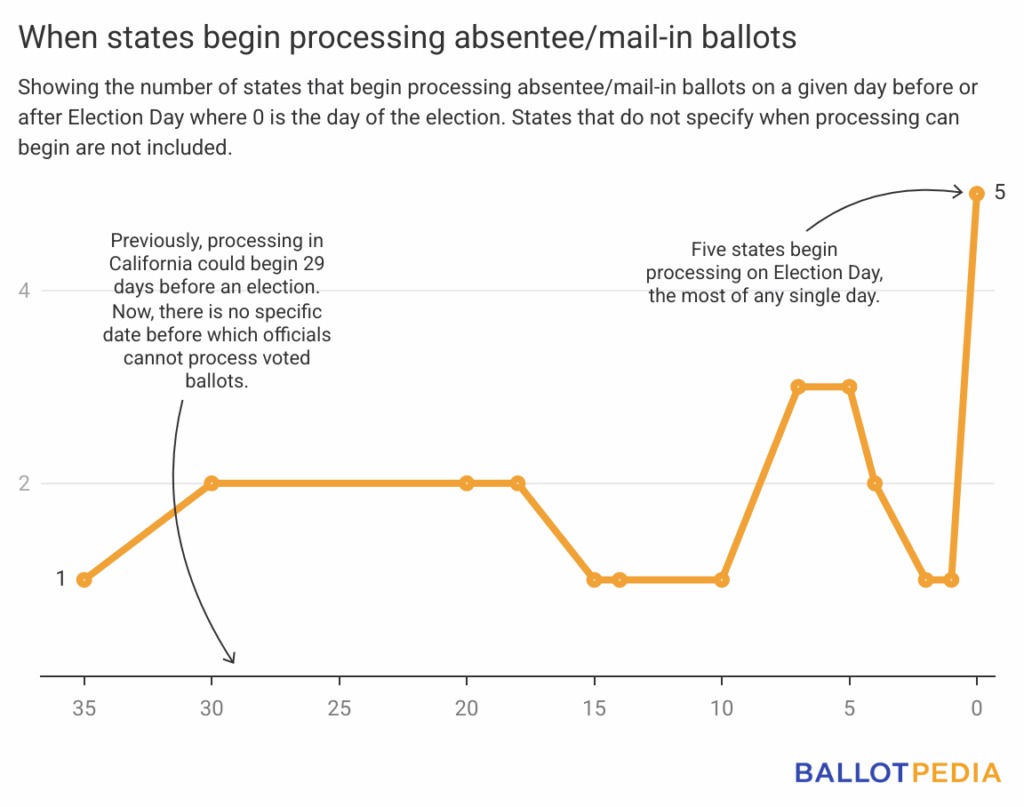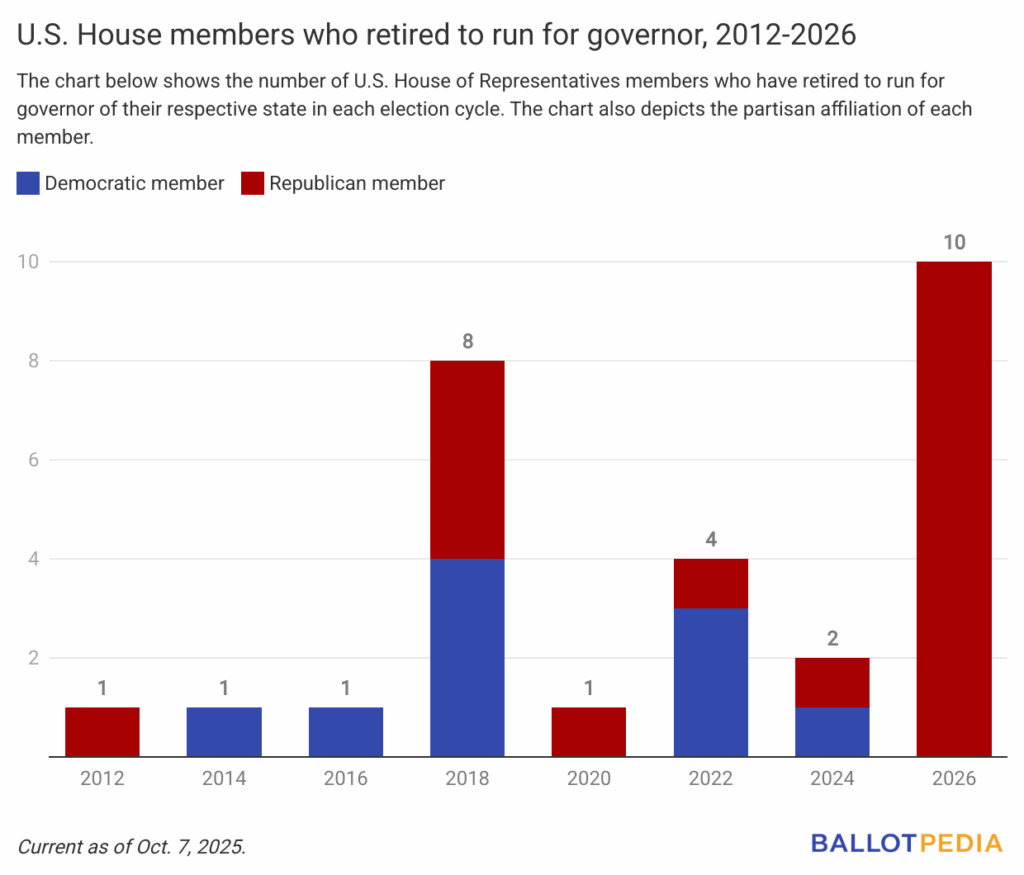Daily Brew: October 9, 2025
Welcome to the Thursday, October 9, Brew.
By: Briana Ryan
Here’s what’s in store for you as you start your day:
- California Gov. Gavin Newsom signs three bills that may affect how quickly unofficial election results are reported
- Ten members of the U.S. House are running for governor of their respective states in 2026
- On the Ballot breaks down how redistricting efforts could affect the 2026 midterm elections
California Gov. Gavin Newsom signs three bills that may affect how quickly unofficial election results are reported
California Gov. Gavin Newsom (D) recently signed three bills—which will take effect on Jan. 1, 2026— that changed the state's rules for processing and counting ballots. In some instances, these new laws may result in quicker unofficial election results.
California typically takes longer to deliver election results than most other states. That's partly due to the state's all-mail voting system, as election officials must complete certain administrative steps before counting vote-by-mail ballots.
California currently allows election officials to begin processing mail-in ballots 29 days before an election, the fourth-earliest of any state. Assembly Bill 16, which Newsom signed on Oct. 1, allows officials to start processing ballots sooner—at any point after they mail ballots to voters. State law does not set a maximum number of days before an election when election officials can start mailing out ballots.
On Oct. 3, Newsom signed bills on reporting requirements for counted ballots and timelines for curing ballots, both of which also affect how quickly unofficial results are reported.
Assembly Bill 5 requires election officials to count most ballots and release a tally of those ballots by the 13th day after an election. Previously, no such deadline existed, and most states do not have a specific deadline for counting ballots and reporting results. The new law makes an exception for certain types of ballots, including those that election officials receive more than four days after the election. California law directs election officials to count all valid ballots received up to seven days after an election, as long as the ballot is postmarked by Election Day.
Assembly Bill 827 moves the latest possible date that election officials can notify a voter about a signature defect from the 22nd day after the election to the 14th, and the latest possible day for a voter to cure a ballot moves from the 28th day to the 22nd day after an election, for regular statewide elections.
AB 5 and AB 16 passed the California Legislature with unanimous support. AB 827 passed the California Assembly 60-5, with two Republicans joining 58 Democrats in voting for the bill. It passed the California Senate 30-5, with all five opposing votes coming from Republicans.
Timelines for election officials to process and count absentee/mail-in ballots, and the steps officials are permitted to take during processing, vary nationwide.
- Nineteen states permit election officials to fully process and scan at least some early and absentee/mail-in ballots before Election Day.
- Twenty-six states and D.C. permit officials to process at least some aspects of these ballots before Election Day.
- In five states, election officials do not begin processing any aspect of absentee/mail-in ballots until Election Day.

In addition to processing and counting rules, other factors affect how quickly unofficial results are reported. These include the resources available to election officials, deadlines for returning absentee/mail-in ballots, provisional ballot procedures, and the presence of jurisdictions that hand-count ballots. Any one of these issues might play a role in how quickly results are reported in given states.
Click here for more information about timelines related to absentee/mail-in ballot processing and counting.
Ten members of the U.S. House are running for governor of their respective states in 2026
On Sept. 30, Rep. David Schweikert (R-Ariz.) announced that he will run for governor of Arizona in 2026, joining nine other members of the U.S. House of Representatives who have announced a 2026 gubernatorial campaign.
The nine other members include Reps. Tom Tiffany (R-Wisc.), Nancy Mace (R-S.C.), Ralph Norman (R-S.C.), Dusty Johnson (R-S.D.), Randy Feenstra (R-Iowa), John James (R-Mich.), John Rose (R-Tenn.), Byron Donalds (R-Fla.), and Andy Biggs (R-Ariz.).
The 10 U.S. House members retiring to run for governor in 2026 is the most to do so since we started following this data in 2012.

So far, two gubernatorial elections have more than one U.S. House member running.
In Arizona, Schweikert and Biggs are competing in the Republican primary. So far, one other Republican candidate, who is not a member of the U.S. House, is also running for governor. Incumbent Gov. Katie Hobbs (D) is running for re-election. As of Oct. 7, three independent race forecasters have rated the general election for the office as a Toss-up.
In South Carolina, Mace and Norman are competing in the Republican primary. So far, three other Republican candidates, who are not members of the U.S. House, are running for governor. Incumbent Gov. Henry McMaster (R) is one of 15 incumbent governors who are term-limited in 2026. As of Oct. 7, three independent race forecasters have rated the general election for the office either Solid Republican or Safe Republican.
There are 36 gubernatorial offices up for election in 2026. Democrats currently hold 18 of those seats, and Republicans hold 18. In the 2024 presidential election, President Donald Trump (R) won 21 of the states where gubernatorial elections are happening in 2026, and Kamala Harris (D) won 13. Additionally, the two states that use the congressional district method in presidential elections are also holding gubernatorial elections in 2026:
- In Maine, Harris won three electoral votes and Trump won one.
- In Nebraska, Trump won four electoral votes and Harris won one.
Click here to read more about the U.S. House members who are running for governor in 2026, and here for more on the 2026 gubernatorial elections.
On the Ballot breaks down how redistricting efforts could affect the 2026 midterm elections
In this episode of On the Ballot, we're examining the states that are moving to redraw their congressional maps ahead of the 2026 midterm elections. The Cook Political Report's Erin Covey joins our host Norm Leahy to break down what's happening and why it matters.
She'll explain the political strategies at play and the legal uncertainties that surround them. Covey will also walk us through the domino effect of Texas's decision, how California, Missouri, Ohio, and Utah fit into the bigger picture, and why deadlines in other states are quickly closing in.
To listen to this episode and more, click here. Also, don't forget to subscribe to On the Ballot on YouTube or wherever you get your podcast. Plus, click here to learn more about congressional redistricting efforts before the 2026 midterm elections.


